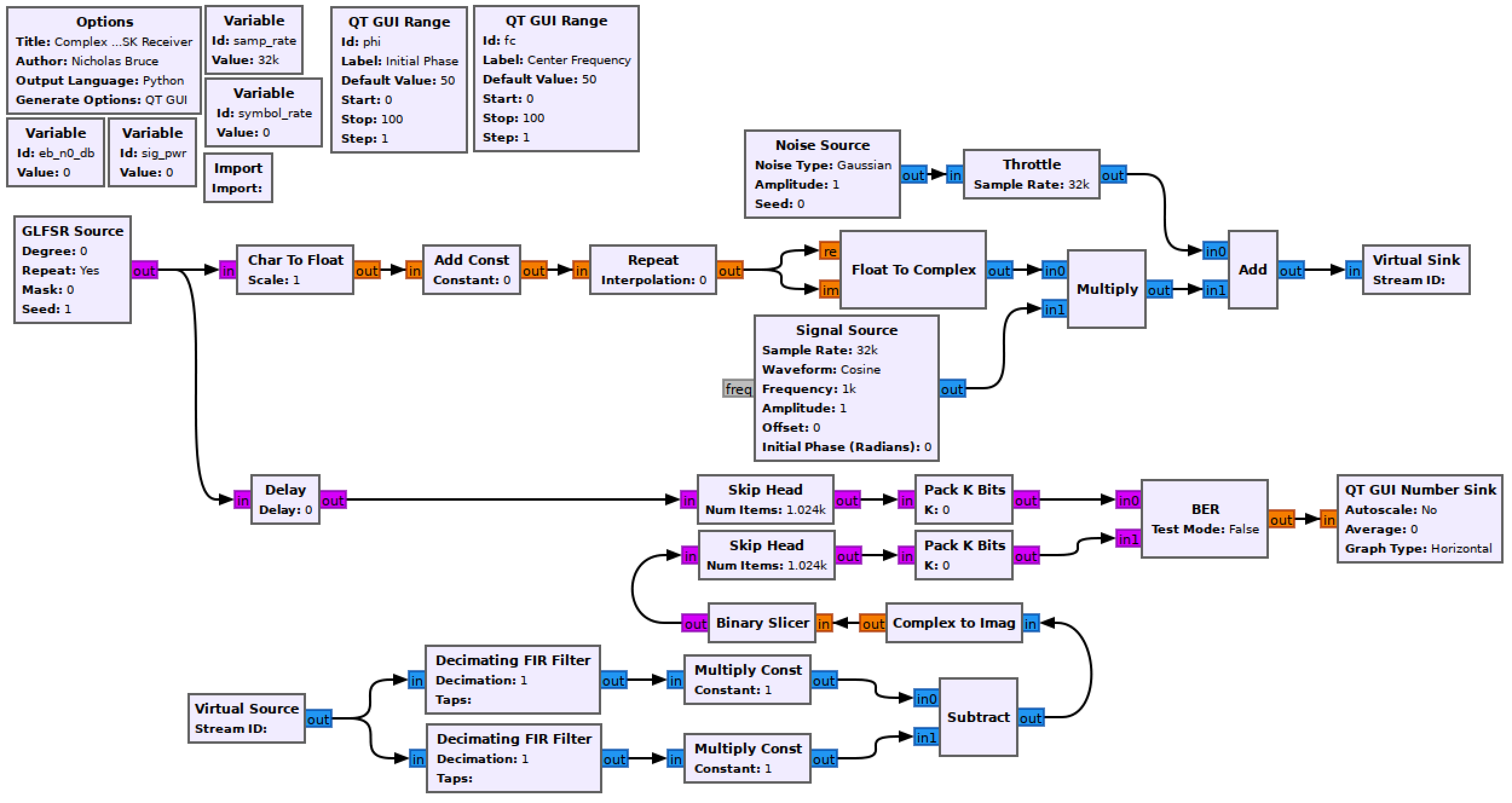Part 3 - Coherent BPSK
Objectives
You will implement a coherent BPSK receiver to demodulate the transmitting signal chain built in the previous lab section.
Part 3 deliverables
For this section, the deliverables are:
- the answer to one deliverable question,
- a dataset for later use in this lab.
Building the flowgraph
Construct the following GRC flowgraph. You can make a copy of the modulating flowgraph from the last section as a starting point by “Save As”-ing it.

Complex coherent BPSK receiver flowgraph
Modulator
Keep the variables and the rest of the modulation chain unchanged.
Notice that since the M-sample-per-symbol bitstream is used for both the real and the imaginary components of the complex stream, the sig_pwr value is 2. This can be confirmed with the a Complex To Mag^2 -> Moving Average -> QT GUI Number Sink chain from previous labs.
Noise Source
Remember from previous labs that the Amplitude variable sets the noise standard deviation, \(\sigma\). Use the following expression to set \(\sigma\) using the eb_n0_db variable.
np.sqrt( sig_pwr/ (10**(eb_n0_db/10)) * samp_rate/symbol_rate )
This is the same expression as from the theory section of the previous lab but where \(\frac{E_b}{N_0}\) is in units of dB.
Receiver chain
This is a coherent receiver which relies on correlating the waveform with taps for a BPSK “+1” (data 1) and “-1” (data 0) and seeing which has a stronger correlation.
Decimating FIR Filter
These blocks will do the correlations against provided taps as well as decimate from M-sample-per-symbol down to 1-sample-per symbol. Set the taps of the upper chain to
np.ones((samp_rate//symbol_rate))+ 1j*np.ones((samp_rate//symbol_rate))
and the taps of the lower chain to
-np.ones((samp_rate//symbol_rate)) - 1j*np.ones((samp_rate//symbol_rate))
These taps will match an M-sample-per-symbol complex baseband “1” and “0” respectively. Set the decimation rate to samp_rate//symbol_rate to match the Repeat block from earlier.
Note
These taps are for the baseband signal. As the center frequency and phase sliders change, the signal is modulated by the changing \(f_c\) and \(\phi\) but the taps do not change. So the center frequency can be considered a frequency offset and the phase can be considered a phase offset. This means that no matter what \(f_c\) and \(\phi\) are the received waveform is being correlated against baseband taps.
Multiply Const
While not strictly necessary since the correlation output is going through a binary slicer, scaling the correlation output by \(\sqrt{2T}\) will put the output of the correlator to \(\sqrt{E}\) to match the theory in Sklar text section 4.4.1.
Set the argument to 1/np.sqrt(2*symbol_rate).
Binary Slicer
This block outputs a 0 for every negative input and a 1 for every positive output.
Delay
The Decimating FIR Filter causes a delay on the receiver signal chain. Use a 1 sample delay to align the signals.
Skip Head
Because of the filter, even once delayed the BER will take time to stabilize. This can be avoided by skipping the first part of each waveform before measuring the BER. Set the argument to 2048.
Pack K Bits
Set K to 8. This is the packet byte size that the later BER block requires.
BER
This computes the error between the two inputs. It outputs to log of the BER, so if it outputs a value of -2, the BER is \(10^{-2}=0.01\).
Set Test Mode to False, which will mean the block immediately starts outputting results (as opposed to waiting for the error rate to stabilize first). While Test Mode is False, the other parameters don’t do anything, so you can leave them as they are.
QT GUI Number Sink
This will draw the output of the BER block on a number line. Set the maximum to 0 (since \(10^0=1\) meaning that every bit is wrong) and the minumum to -7.
Run the experiment
- Run the flowgraph.
- Record the BER at \(\frac{E_b}{N_0}\) values of
[0, 2, 4, 6, 8]. You will need to kill the flowgraph each time you need to set a new value.- Plotting GUI sink values also eats computational power. While waiting for the BER values to stabilize you may wish to disable any unneeded QT GUI blocks.
- Put a
0*in front of the Noise Amplitude argument. Restart the flowgraph and confirm that the BER is 0 (meaning no bit errors). Now change \(\phi\) by a very small amount. Observe the BER rising. - Set \(\phi\) back to 0 and change \(f_c\) by a small amount. Observe the BER rising.
At this point you should have recorded 5 BER values.
Deliverable question 2
What does changing \(\phi\) and \(f_c\) tell you about the phase coherency and frequency stability requirement of the receiver? How would a system like this be built in real life (i.e. how could coherency be maintained between transmitter and receiver)?
Review the section deliverables before moving on.
UVic ECE Communications Labs
Lab manuals for ECE 350 and 450